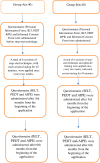Comparison of the results of stop-start technique with stop-start technique and sphincter control training applied in premature ejaculation treatment
- PMID: 37561708
- PMCID: PMC10414676
- DOI: 10.1371/journal.pone.0283091
Comparison of the results of stop-start technique with stop-start technique and sphincter control training applied in premature ejaculation treatment
Abstract
Background: The aim of this study is to compare the results of stop-start technique with stop-start technique together with sphincter control training applied in the treatment of premature ejaculation.
Methods: This research was conducted as a pre-test post-test quasi-experimental study. The sample of the study consisted of 80 men. The study was conducted on men who applied to the urology outpatient clinic of LIV Hospital, a prıvate hospital, in Gaziantep, Turkey, between 01 October 2021 and 01 March 2022. "Personal Information Form", "Intravaginal Ejaculation Latency Time (IELT)", "Fold Increase Intravaginal Ejaculation Latency Time (F-IELT)" "Premature Ejaculation Diagnostic Tool (PEDT) Questionnaire" and "Arabic Index Premature Ejaculation (AIPE)" were used as the data collection tools. Behavioral therapy, consisting of a total of 6 sessions, was applied once every two weeks, with each session lasting for 45 minutes. After 3rd and 6th months from the beginning of the application, the data collection tools were applied again. "Stop-Start Technique (Group A)" and "Stop-Start Technique and Sphincter Control Training (Group B)" were used in the treatment.
Results: In both groups, the IELT and AIPE values after 3rd and 6th months from the beginning of the application were statistically higher than those obtained before (p<0.05). IELT and AIPE values increased more in Group B than Group A (p<0.05). F-IELT values after 6th months from the beginning of the application were found to be statistically significant with a low level of effect size than those obtained before (p<0.05, Cohen's d = 0.027). In both groups, the PEDT values in the 3rd and 6th months after the application were statistically lower than those seen before (p<0.05). PEDT value decreased more in Group B than Group A (p<0.05). The differences between the two groups' IELT (Cohen's d = 0.011), AIPE (Cohen's d = 0.044), and PEDT (Cohen's d = 0.066) values in the 3rd month after the application and IELT (Cohen's d = 0.025), AIPE (Cohen's d = 0.048), and PEDT (Cohen's d = 0.024) values in the 6th month after the application were found to be clinically weak.
Conclusions: It was determined that the stop-start technique given to men with premature ejaculation increased the time spent in the vagina and eliminated the problem of premature ejaculation. It was determined that the stop-start technique in combination with sphincter control training were more effective than the stop-start technique alone.
Copyright: © 2023 Doğan, Keçe. This is an open access article distributed under the terms of the Creative Commons Attribution License, which permits unrestricted use, distribution, and reproduction in any medium, provided the original author and source are credited.
Conflict of interest statement
The authors have declared that no competing interests exist.
Figures
Similar articles
-
Daily intake of 30 mg duloxetine is effective in decreasing premature ejaculation severity: a prospective randomized placebo-controlled cross over clinical trial.Basic Clin Androl. 2023 Dec 5;33(1):34. doi: 10.1186/s12610-023-00210-1. Basic Clin Androl. 2023. PMID: 38049720 Free PMC article.
-
[Evaluation of the efficacy of dapoxetine in primary and secondary forms of premature ejaculation].Urologiia. 2022 Mar;(1):46-49. Urologiia. 2022. PMID: 35274858 Russian.
-
The comparison of premature ejaculation assessment questionnaires and their sensitivity for the four premature ejaculation syndromes: results from the Turkish society of andrology sexual health survey.J Sex Med. 2011 Apr;8(4):1177-85. doi: 10.1111/j.1743-6109.2010.02183.x. Epub 2011 Jan 26. J Sex Med. 2011. PMID: 21269396
-
An evidence-based unified definition of lifelong and acquired premature ejaculation: report of the second International Society for Sexual Medicine Ad Hoc Committee for the Definition of Premature Ejaculation.J Sex Med. 2014 Jun;11(6):1423-41. doi: 10.1111/jsm.12524. Epub 2014 May 22. J Sex Med. 2014. PMID: 24848805 Review.
-
Behavioral Therapies for Management of Premature Ejaculation: A Systematic Review.Sex Med. 2015 Sep;3(3):174-88. doi: 10.1002/sm2.65. Epub 2015 May 8. Sex Med. 2015. PMID: 26468381 Free PMC article. Review.
Cited by
-
Video platforms and sexual healthcare in China: assessment of content on premature ejaculation.Transl Androl Urol. 2025 Mar 30;14(3):729-739. doi: 10.21037/tau-2025-104. Epub 2025 Mar 26. Transl Androl Urol. 2025. PMID: 40226064 Free PMC article.
References
-
- American Psychiatric Association. Diagnostic and statistical manual of mental disorders, 5th ed. Arlington VA: American Psychiatric Association, 2013.
-
- Serefoglu EC, McMahon CG, Waldinger MD, Althof SE, Shindel A, Adaikan G, et al.. An evidence-based unified definition of lifelong and acquired premature ejaculation: report of the second international society for sexual medicine ad hoc committee for the definition of premature ejaculation. Sex Med. 2014;2(2): 41–59. doi: 10.1002/sm2.27 - DOI - PMC - PubMed
-
- Laumann EO, Glasser DB, Neves RCS, Moreira ED. A population-based survey of sexual activity, sexual problems and associated help-seeking behavior patterns in mature adults in the United States of America. International Journal of Impotence Research. 2009;21(3): 171–178. doi: 10.1038/ijir.2009.7 - DOI - PubMed
-
- Serefoglu EC, Yaman O, Cayan S, Asci R, Orhan I, Usta MF, et al.. Prevalence of the complaint of ejaculating prematurely and the four prematüre ejaculation syndromes: results from the Turkish Society of Andrology Sexual Health Survey. The Journal of Sexual Medicine. 2011;8(2): 540–548. doi: 10.1111/j.1743-6109.2010.02095.x - DOI - PubMed
-
- Althof SE. Psychological approaches to the treatment of rapid ejaculation. J Mens Health Gender. 2006;3: 180–186.
MeSH terms
LinkOut - more resources
Full Text Sources



